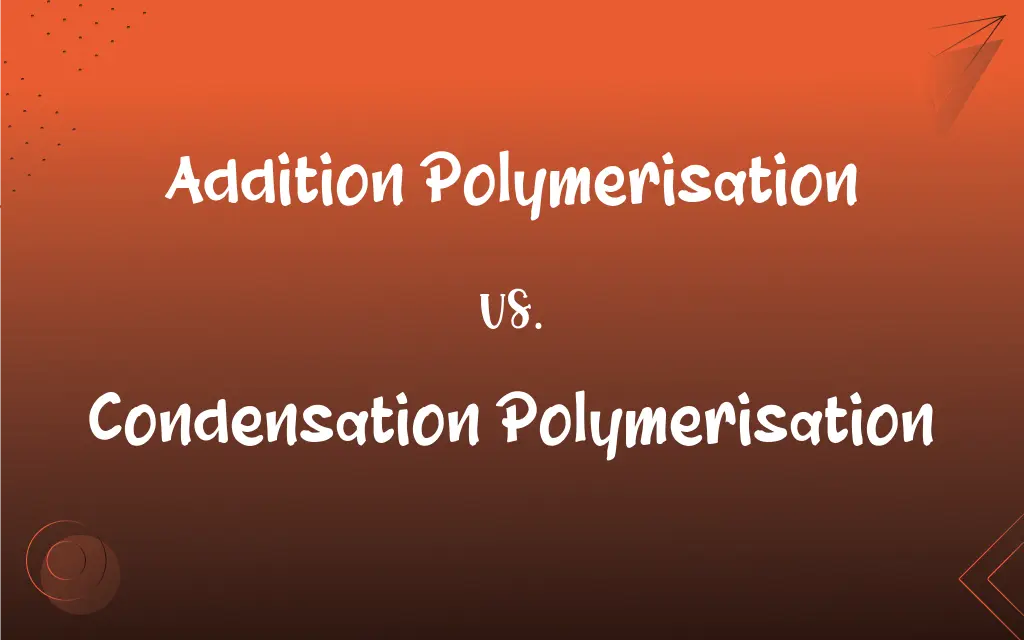Addition Polymerisation vs. Condensation Polymerisation: What's the Difference?
Edited by Aimie Carlson || By Harlon Moss || Updated on October 23, 2023
Addition polymerisation involves monomers with double bonds forming polymers without byproducts. Condensation polymerisation joins monomers with the elimination of a small molecule, like water.

Key Differences
Addition polymerisation is a process where monomers having unsaturated double bonds combine to form a polymer. In this process, the polymer is formed without the loss of any atom or molecule. Conversely, condensation polymerisation involves the joining of monomers with the elimination of a small molecule, such as water, as a byproduct.
In addition polymerisation, the monomers used contain carbon-carbon double bonds, which break to form the polymer. In condensation polymerisation, the monomers contain reactive functional groups that lead to the formation of covalent bonds between them, eliminating a small molecule in the process.
Polymers formed through addition polymerisation typically don't have functional groups along their backbone, leading to non-polar, often high-strength materials. Condensation polymerisation, on the other hand, can result in polymers with functional groups, often making them more versatile in applications.
One notable feature of addition polymerisation is that it usually requires initiators or catalysts to start the reaction. Whereas in condensation polymerisation, the presence of functional groups in the monomers themselves can drive the reaction forward.
Addition polymerisation is typically used to produce polymers like polyethylene and polystyrene. Condensation polymerisation is responsible for polymers such as nylon and polyester.
ADVERTISEMENT
Comparison Chart
Byproduct
No byproducts produced.
Small molecules like water are eliminated.
Monomer Bond Type
Contains double bonds.
Contains reactive functional groups.
Type of Polymers Produced
Non-polar, high-strength materials.
Versatile polymers with functional groups.
Catalysts/Initiators
Often requires initiators.
Driven by functional groups.
Examples
Polyethylene, polystyrene.
Nylon, polyester.
ADVERTISEMENT
Addition Polymerisation and Condensation Polymerisation Definitions
Addition Polymerisation
A polymerisation technique not producing small molecules.
In addition polymerisation, the entire monomer molecule is incorporated into the polymer.
Condensation Polymerisation
Responsible for many biopolymers in nature.
Condensation polymerisation is behind the formation of natural fibers like silk.
Addition Polymerisation
A process where unsaturated monomers combine without byproduct elimination.
Polyethylene is made through addition polymerisation of ethene molecules.
Condensation Polymerisation
Involves monomers with functional groups to produce polymers.
Polyester is made via condensation polymerisation of dicarboxylic acids and diols.
Addition Polymerisation
The reaction of monomers with double bonds to produce polymers.
Polystyrene results from the addition polymerisation of styrene.
Condensation Polymerisation
Doesn't generally require external initiators.
The condensation polymerisation of amino acids to form proteins is self-driven.
Addition Polymerisation
Needs initiators to start the polymerisation reaction.
To create PVC, addition polymerisation of vinyl chloride is initiated using catalysts.
Condensation Polymerisation
A polymer formation process that eliminates a small molecule.
Nylon forms through condensation polymerisation, releasing water.
Addition Polymerisation
Used to produce non-polar polymers without functional groups.
Through addition polymerisation, polypropylene is obtained from propene.
Condensation Polymerisation
Produces polymers with functional groups along their backbone.
Polyurethanes result from condensation polymerisation of diisocyanates with polyols.
FAQs
Can condensation polymerisation produce versatile polymers?
Yes, condensation polymerisation can yield polymers with diverse functional groups.
What's the main byproduct in addition polymerisation?
Addition polymerisation produces no byproducts.
Is polyethylene a product of addition polymerisation?
Yes, polyethylene results from addition polymerisation of ethene.
Which polymerisation results in non-polar polymers?
Addition polymerisation typically yields non-polar polymers.
Do addition polymerisation polymers have functional groups?
Typically, polymers from addition polymerisation lack functional groups in their backbone.
Does condensation polymerisation result in the release of a molecule?
Yes, condensation polymerisation often releases small molecules like water.
Which polymerisation is behind natural biopolymers?
Condensation polymerisation is often behind natural biopolymers.
What drives the reaction in condensation polymerisation?
The presence of functional groups in monomers drives the condensation polymerisation reaction.
Are catalysts used in addition polymerisation?
Yes, addition polymerisation often requires catalysts or initiators.
Can proteins be formed through condensation polymerisation?
Yes, proteins form through condensation polymerisation of amino acids.
Which polymerisation uses monomers with double bonds?
Addition polymerisation utilizes monomers with double bonds.
Does addition polymerisation create versatile polymers like condensation polymerisation?
Addition polymerisation primarily yields non-polar, high-strength materials, whereas condensation polymerisation can produce versatile polymers.
What is a common byproduct of condensation polymerisation?
Water is a frequent byproduct of condensation polymerisation.
Are all plastics made by addition polymerisation?
No, plastics can result from both addition polymerisation and condensation polymerisation.
What is the bond type in monomers for addition polymerisation?
Monomers for addition polymerisation contain carbon-carbon double bonds.
Is polyester made via condensation polymerisation?
Yes, polyester is made through condensation polymerisation.
Is nylon an outcome of condensation polymerisation?
Yes, nylon is produced through condensation polymerisation.
Is polypropylene a product of addition polymerisation?
Yes, polypropylene results from addition polymerisation of propene.
Are initiators necessary in condensation polymerisation?
Generally, condensation polymerisation is driven by functional groups and doesn't need external initiators.
Which polymerisation technique uses reactive functional groups in monomers?
Condensation polymerisation uses monomers with reactive functional groups.
About Author
Written by
Harlon MossHarlon is a seasoned quality moderator and accomplished content writer for Difference Wiki. An alumnus of the prestigious University of California, he earned his degree in Computer Science. Leveraging his academic background, Harlon brings a meticulous and informed perspective to his work, ensuring content accuracy and excellence.
Edited by
Aimie CarlsonAimie Carlson, holding a master's degree in English literature, is a fervent English language enthusiast. She lends her writing talents to Difference Wiki, a prominent website that specializes in comparisons, offering readers insightful analyses that both captivate and inform.































































